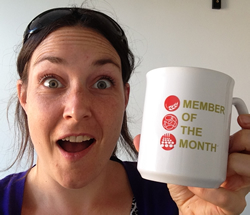Martha Skinner was nominated as IFST's member of the month for her involvement in the Student Working Group. Martha is also involved in the Sensory Science Group.
How does it feel to be recognised as 'Member of the Month'?
I was delighted to be awarded the IFST member of the month title. It is fantastic to be involved in such a great organisation, and it’s nice to know the time I’ve spent volunteering has been appreciated.
You actually joined IFST through a competition! Tell us about your experience of IFST so far
Yes I got involved with the group when I received a free 1 year IFST membership as a prize for a flash poster presentation I did at the Nursten Flavour Symposium 2014. I then decided to join the committee for the Sensory Science Group, and became Chair of the Student Working Group. Although still quite new to the committee, I have enjoyed attending the conferences and workshops, and am looking forward to more involvement in the future.
Why is it important to be a member of a body like IFST?
Being a member of the IFST has already given me the opportunity to network and meet many like-minded people. It is a good way of integrating those working in the academic environment with those from industry. It provides opportunities to go to conferences and events where you can share research ideas and learn from one another.
You are a member of our Student Group, and have a particular focus on Sensory. Why is it important to have a student voice within IFST?
Students will play such an important role in the future of Sensory Science, and so it is important that they have a voice within the group. Also it is a way of promoting Sensory Science to other students who may not be working directly in the field, but who are interested in Sensory Science, or may wish to incorporate it into their work.
You are currently doing a PhD; tell us a little about it.
I’m half way through a 4 year PhD which is very exciting as it is using Sensory Science and functional magnetic resonance imaging (fMRI) to investigate taste perception in the human brain. There are currently 5 known tastes (sweet, sour, salty, bitter, umami) and the ultimate aim is to map where these tastes are represented within the taste cortex of the brain. I am also investigating two proposed tastes which are fat and metallic, as well as looking at variation in taste perception across people. It’s a great area to be working in, and every day I feel very lucky to be working on something I feel so passionate about.
Tell us something about yourself that not many people know:
I have always been passionate about food, and when I was a child I wanted to be a baker! It is this passion that drove me to pursue research into taste perception. I rarely find the time to bake any more, but am still a keen cook and love relating my research into everyday food experiences.

